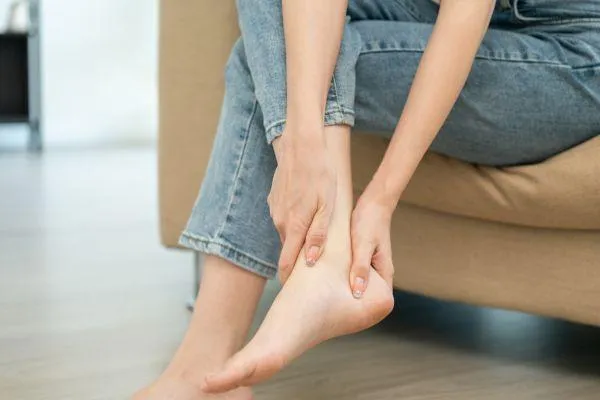
What You Need to Know About Foot Drop and How It Affects Your Mobility
Foot drop, also known as drop foot, is a condition that affects your ability to lift the front part of your foot. It can make walking challenging, as the foot may drag along the ground, increasing the risk of tripping and falling. While it might sound like a minor inconvenience, foot drop can significantly impact your mobility and quality of life.
In this post, we’ll explore what foot drop is, how it affects movement, and the best ways to manage it.
What is Foot Drop?
Foot drop is a condition characterised by difficulty lifting the front part of the foot, particularly the toes. This occurs due to weakness or paralysis of the muscles responsible for lifting the foot, primarily the tibialis anterior muscle, which runs along the front of the lower leg. As a result, individuals with foot drop often experience the foot dragging or “slapping” against the ground when walking.
Foot drop can be temporary or permanent, depending on the underlying cause. It is typically caused by nerve damage or muscle weakness, often as a result of neurological conditions, trauma, or other medical conditions.
How Foot Drop Affects Your Mobility
Foot drop can significantly alter the way you walk and move. Because the foot cannot be lifted properly, it can cause a number of challenges:
Increased Risk of Tripping and Falling:
One of the most noticeable effects of foot drop is the tendency for the foot to drag while walking. This increases the risk of tripping or stumbling, especially when walking on uneven surfaces or navigating stairs.Altered Gait:
To compensate for the inability to lift the foot, individuals with foot drop may develop a high-stepping gait or exaggerated lifting of the leg (called “steppage gait”) to avoid dragging the foot. This can lead to muscle fatigue, discomfort, and strain on other parts of the body.Pain and Discomfort:
The compensatory actions used to avoid dragging the foot can result in pain in the hips, knees, or lower back due to abnormal posture or gait patterns. Over time, this can lead to additional musculoskeletal issues.Reduced Mobility and Independence:
As foot drop makes walking more difficult, individuals may begin to avoid walking altogether, leading to a decline in overall mobility. This can impact everyday activities such as walking, climbing stairs, and even standing for long periods.
Causes of Foot Drop
Foot drop can be caused by a variety of factors, most of which are related to nerve damage or muscle weakness. Some of the most common causes include:
Nerve Injury:
Damage to the peroneal nerve, which controls the muscles responsible for lifting the foot, is one of the most common causes of foot drop. This can occur from injury, trauma, or compression, such as from a car accident, surgery, or prolonged pressure on the knee.Neurological Conditions:
Conditions such as stroke, multiple sclerosis (MS), cerebral palsy, and amyotrophic lateral sclerosis (ALS) can affect the brain, spinal cord, or nerves, leading to foot drop. These conditions impair the signals from the brain to the muscles, resulting in weakness or paralysis of the foot-lifting muscles.Muscle or Tendon Disorders:
Disorders like muscular dystrophy, which cause progressive muscle weakness, can also lead to foot drop. Conditions affecting the tendons and muscles of the lower leg can prevent the foot from lifting properly.Diabetes:
People with diabetes may develop peripheral neuropathy, which damages the nerves in the feet and legs. This can impair the function of the muscles that control foot movement, contributing to foot drop.Trauma or Injury:
Fractures, surgery, or even a slipped disc in the spine can lead to nerve damage, resulting in foot drop.
Managing Foot Drop
While foot drop can be a challenging condition, there are various strategies and treatments available to help manage it and improve mobility:
Ankle-Foot Orthoses (AFOs):
AFOs are specially designed braces that help support the foot and ankle, allowing individuals to lift the foot properly while walking. They provide stability and prevent the foot from dragging, making walking easier and safer.Physical Therapy:
Physical therapy can help improve strength, flexibility, and coordination in the affected leg and foot. A physical therapist will work with you to develop exercises that strengthen the muscles responsible for lifting the foot and improve your gait.Nerve Stimulation:
In some cases, electrical stimulation therapy may be used to activate the nerves that control foot movement. This therapy involves using mild electrical impulses to stimulate the peroneal nerve and improve foot lifting.Surgical Options:
In severe cases of foot drop that don’t respond to other treatments, surgery may be considered. Surgical options can include tendon transfer, which involves rerouting a functioning tendon to help lift the foot, or nerve decompression surgery to relieve pressure on the affected nerve.Custom Orthotics:
Custom-made shoe inserts can provide additional support and cushioning, making walking easier and more comfortable for people with foot drop.Lifestyle Adjustments:
Modifying your environment by adding grab bars, ramps, or railings to make moving around easier can also help reduce the risks associated with foot drop, such as tripping and falling.
When to Seek Professional Help
If you’re experiencing symptoms of foot drop, such as difficulty lifting your foot or dragging it while walking, it’s important to consult a podiatrist. Early intervention can help identify the underlying cause and prevent the condition from worsening. A podiatrist can also recommend the most appropriate treatments to improve mobility and quality of life.
At Peak Podiatry, we specialise in diagnosing and treating foot drop. Whether through physical therapy, custom orthotics, or advanced treatments, we’re here to help you regain your mobility and independence.
Contact us today to schedule an appointment and take the first step toward better mobility!
Ask Robert And His Team
Fill in the form to request a Call From Our Team
Fill in the form to request a Call From Our Team
One of our team will call you for FREE and answer any questions or concerns you may have about your Foot Pain.
One of our team will call you for FREE and answer any questions or concerns you may have about your Foot Pain.
© Copyright 2022. Peak Podiatry All rights reserved.





